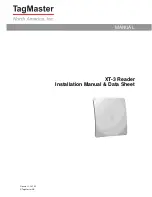
202
9440300990 Rev J
Modbus™ Communication
DECS-250
CRC Lo error check
Response
The response message echoes the Query message after the register has been altered.
Data Formats
DECS-250 systems support the following data types:
•
Data types mapped to 2 registers
o
Unsigned Integer 32 (Uint32)
o
Floating Point (Float)
o
Strings maximum 4 characters long (String)
•
Data types mapped to 1 register
o
Unsigned Integer 16 (Uint16)
o
Unsigned Integer 8 (Uint8)
o
Strings maximum 2 characters long (String)
•
Data types mapped to more than 2 registers
o
Strings longer than 4 characters (String)
Floating Point Data Format (Float)
The Modbus floating point data format uses two consecutive holding registers to represent a data value.
The first register contains the low-order 16 bits of the following 32-bit format:
•
MSB is the sign bit for the floating-point value (0 = positive).
•
The next 8 bits are the exponent biased by 127 decimal.
•
The 23 LSBs comprise the normalized mantissa. The most-significant bit of the mantissa is always
assumed to be 1 and is not explicitly stored, yielding an effective precision of 24 bits.
The value of the floating-point number is obtained by multiplying the binary mantissa times two raised to
the power of the unbiased exponent. The assumed bit of the binary mantissa has the value of 1.0, with
the remaining 23 bits providing a fractional value. Table 22 shows the floating-point format.
Table 22. Floating Point Format
Sign
Ex 127
Mantissa
1 Bit
8 Bits
23 Bits
The floating-point format allows for values ranging from approximately 8.43X10
-37
to 3.38X10
38
. A floating-
point value of all zeroes is the value zero. A floating-point value of all ones (not a number) signifies a
value currently not applicable or disabled.
Example: The value 95,800 represented in floating-point format is hexadecimal 47BB1C00. This number
will read from two consecutive holding registers as follows:
Holding Register
Value
K (Hi Byte)
hex 1C
K (Lo Byte)
hex 00
K+1 (Hi Byte)
hex 47
K+1 (Lo Byte)
hex BB
The same byte alignments are required to write.
Long Integer Data Format (Uint32)
The Modbus long integer data format uses two consecutive holding registers to represent a 32-bit data
value. The first register contains the low-order 16 bits and the second register contains the high-order 16
bits.
Summary of Contents for DECS-250
Page 2: ......
Page 6: ...iv 9440300990 Rev J Revision History DECS 250 ...
Page 16: ...xiv 9440300990 Rev J Contents DECS 250 ...
Page 20: ...4 9440300990 Rev J Introduction DECS 250 ...
Page 28: ...12 9440300990 Rev J Power Stage DECS 250 ...
Page 32: ...16 9440300990 Rev J Voltage and Current Sensing DECS 250 ...
Page 40: ...24 9440300990 Rev J Synchronizer DECS 250 ...
Page 52: ...36 9440300990 Rev J Auxiliary Control DECS 250 ...
Page 56: ...40 9440300990 Rev J Contact Inputs and Outputs DECS 250 ...
Page 84: ...68 9440300990 Rev J Limiters DECS 250 ...
Page 114: ...98 9440300990 Rev J Power System Stabilizer DECS 250 Figure 96 PSS Parameter Settings ...
Page 124: ...108 9440300990 Rev J Stability Tuning DECS 250 ...
Page 126: ...110 9440300990 Rev J Mounting DECS 250 Figure 103 Overall and Projection Mounting Dimensions ...
Page 127: ...9440300990 Rev J 111 DECS 250 Mounting Figure 104 DECS 250 Escutcheon Plate Dimensions ...
Page 198: ...182 9440300990 Rev J Timekeeping DECS 250 ...
Page 210: ...194 9440300990 Rev J CAN Communication DECS 250 ...
Page 304: ...288 9440300990 Rev J Maintenance DECS 250 ...
Page 316: ...300 9440300990 Rev J Specifications DECS 250 ...
Page 334: ...318 9440300990 Rev J Analog Expansion Module DECS 250 ...
Page 351: ......
















































